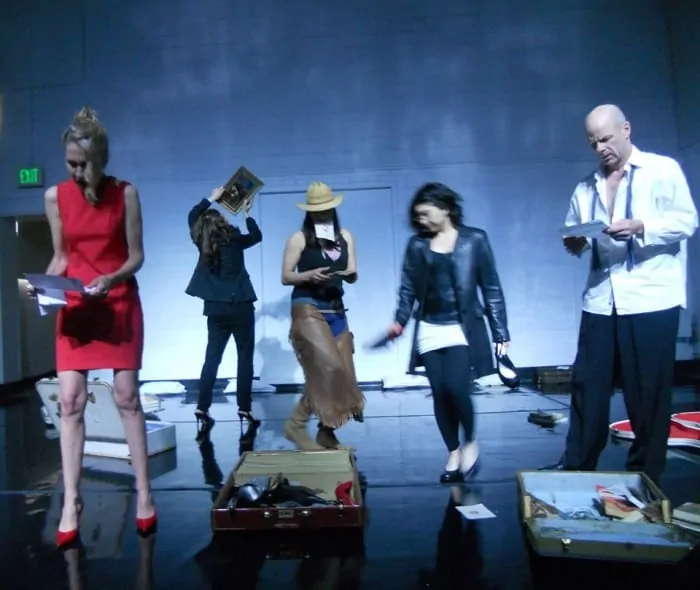Bay Area Critic-at-Large Greg Alonzo reviews Quantum Love at Inferno Theatre Company.
This is a fascinating contemplation on how human love operates under the same principles governed by quantum theory, general relativity and their various components.
Although the story is nonlinear and decidedly unconventional, the central theme is carried inexorably forward, much in the same way one can follow the direction of a ball in a game of pinball – the path may appear haphazard, but important points are scored along the way.
At times playwright Giulio Cesare Perrone’s (artistic director of Inferno Theatre Company) premise is presented as more analogy than metaphor. That’s apparent early on inasmuch as he points out that the human body is composed mostly of water molecules, subject to the same laws of physics as any other atomic structure.
And yet, he doesn’t hesitate to toss in a metaphor here or there whenever it suits his purpose. For example, we’re reminded, with the help of some nicely conceived and executed multi-media projection, that among water’s many properties is that it travels in waves, just as electro-magnetic particles do.
As one might expect, music is also integrated into the performance, whether it be a brief, touching violin solo by the talented Emmy Pierce (as “Air”), or an amusing “rap” sequence sung by the entire cast. Dance and movement is ubiquitous as well, including some modest yet effective tango numbers (courtesy of Tango Maestro Robert Fields).

The rhetorical effect of these devises is obvious, yet the elegant direction by Mr. Perrone and skilled improvisation by the ensemble manage to insert the music and choreography discreetly into the overall staging.
This is a fascinating contemplation on how human love operates under the same principles governed by quantum theory.
The journey begins with each performer carrying a suitcase as they travel through the “time space continuum.” As they unload their baggage, the action unfolds as a series of familiar romantic encounters, with each vignette a variation on the central premise. “Love,” in all its permutations, is explored as the characters attempt to explain the process in objective scientific terms. It’s as if Carl Sagan had been tapped as a script consultant to lend his both perspective and authenticity to the proceedings.
Of course, the nature of love is anything but dispassionate, and there’s a danger that the arcane jargon could rob the piece of its very humanity. Indeed, whatever the origin and purpose of love may be, it can often have profound emotional consequences, whose description is better suited for a more poetic sensibility, rather than the cold, empirical observations of the scientific mind.
Perhaps in recognition of this potential shortcoming, the author seamlessly interweaves quotations borrowed from the definitive poetic dramatist – William Shakespeare.
Surprisingly, the Bard complements the play quite well, and gives it a gravitas and insight into the human condition that no theory of gravity could ever hope to provide. It’s undeniable that the truths he observed some 400 years ago play themselves out in human interactions on a daily basis and are forever relevant.
Then again, one could argue that the poet vs. scientist schism is a false dichotomy; that is, Shakespeare’s words may ultimately simply be a reflection of a consciousness brought to bear by an evolving universe billions of years old.
We are treated to a wonderful reading of a play within a play – the “Nunnery Scene” from “Hamlet,” with an understated and cerebral Michael Needham (as “Andrea”) as the beleaguered Prince of Denmark, unleashing a brutal tirade upon an undeserving and guileless Ophelia (a charming Jody Christian- “Judith”). The pain his betrayal inflicts upon one so fragile leads inevitably to a tragic act of desperation, and reminds one that the interaction of even nano-particles can bestow a ripple effect not always considered.
“I read that the world is flat!”
But then, out of nowhere, Mr. Perrone pulls the rug ostensibly from under his core supposition and pens the best line of the piece “I read that the world is flat!”
Delivered with a devilish naivete by a disarming Tenya Spillman (as “Giulia”) who, donned in a seductive red dress and heels, portrays in one scene an all too convincing “material girl” persona that won’t be bothered with such intangible, esoteric concepts as “particle theory.” Madonna, not to mention Marilyn, would be proud!
It’s evident, however, that this visionary playwright is confident enough in the intent and meaning of his own material to acknowledge throughout that the “physical laws” are nothing more than a transitory exercise of the human mind to get some sort of handle on the meaning and mysteries of existence.
This is essentially an expressionistic work. As such, it employs symbolism through the use of props, immersive lighting, and mood-altering music, and designers Perrone, Mike Sweeney, and Bruno Louchouarn, respectively, do an admirable job setting the tone without ever falling prey to any self-indulgent tendencies.
Among the many symbols we witness are ebony angel’s wings borne appropriately by two characters who bear the names of “Gabriel” and “Arariel,” both angels stemming from Judeo-Christian tradition. Each is rendered with appropriate grace by a down-to-earth and natural G. Scott Heath, and a wise and mysterious Simone Bloch, respectively.
Angels may at first blush seem out of place here, but somehow it all makes sense in this entertaining potpourri of big ideas from a critical thinker with a heart of a poet. Maestro Perrone should be commended for pulling-off such an ambitious project – on a shoestring budget – without ever compromising his artistic integrity.
Bravo!



